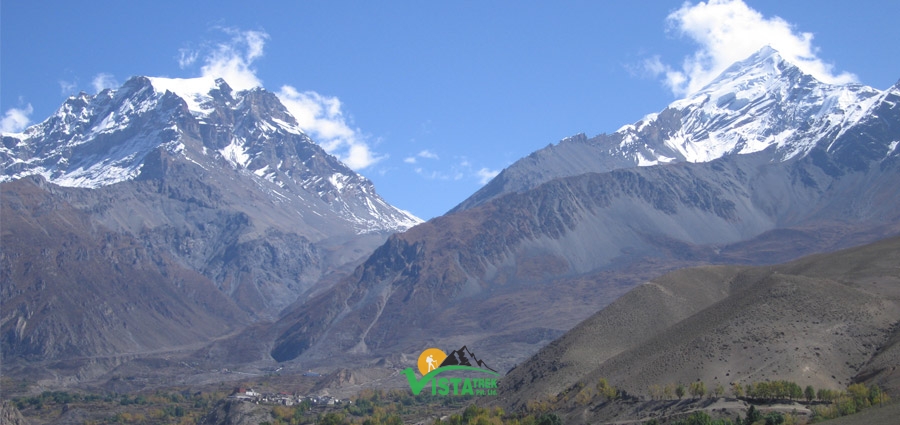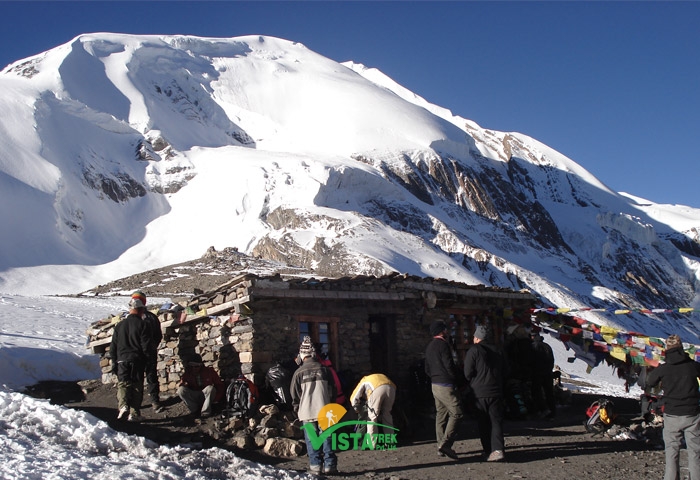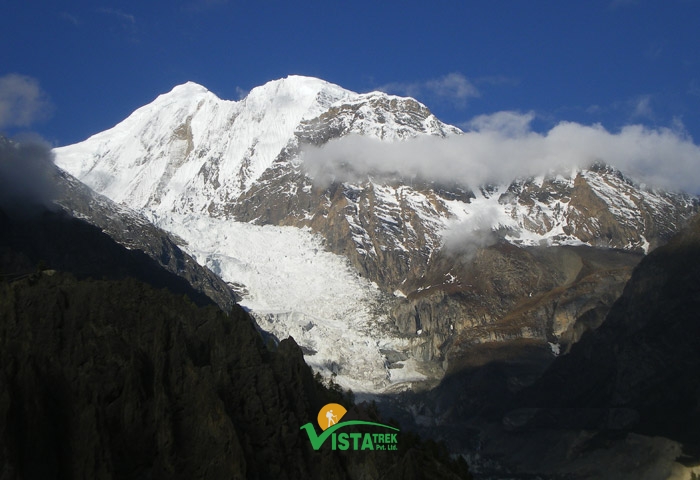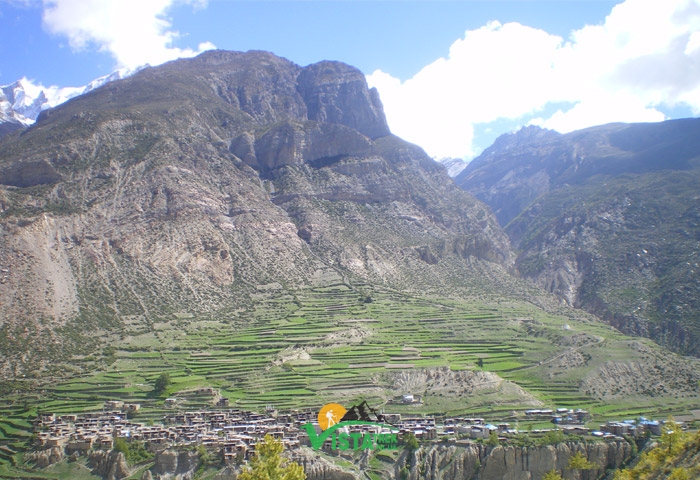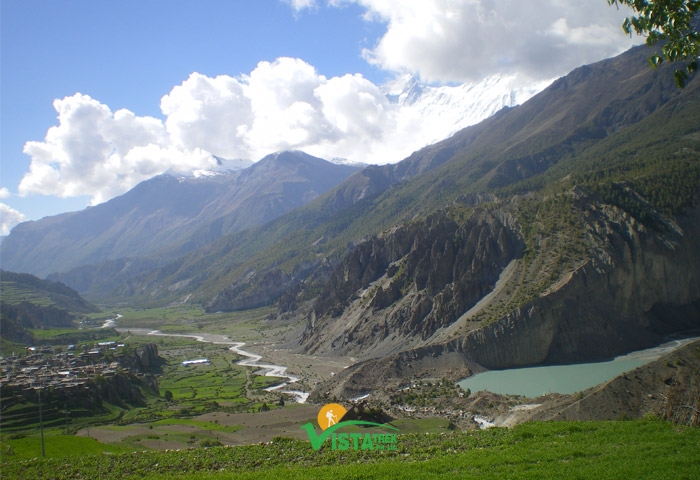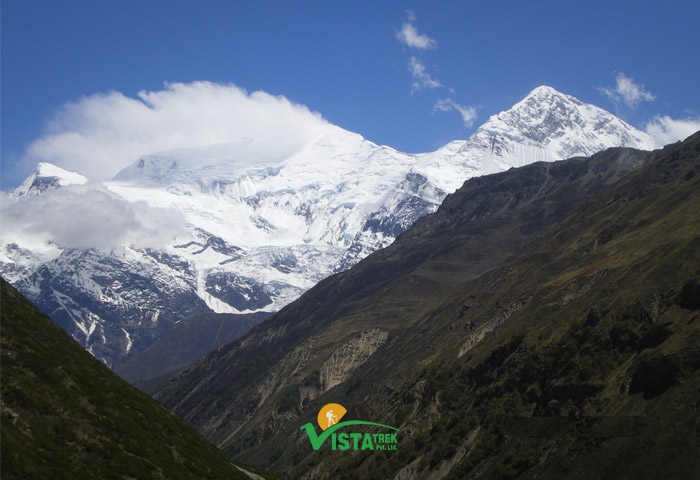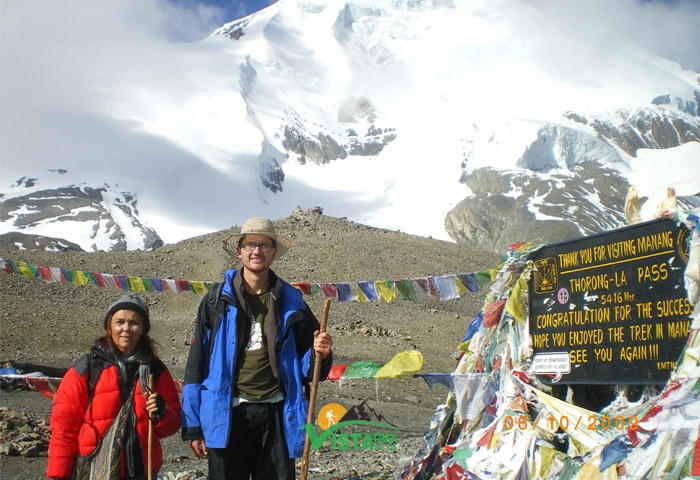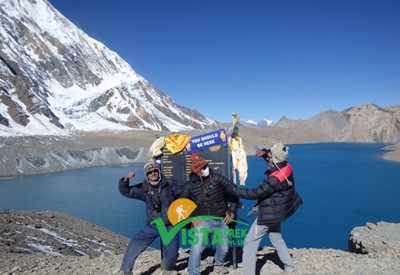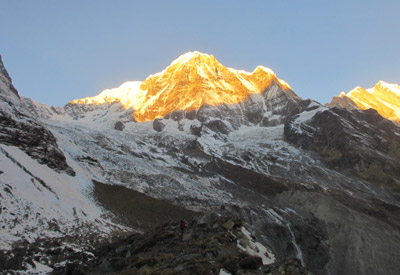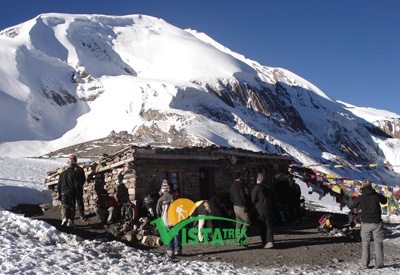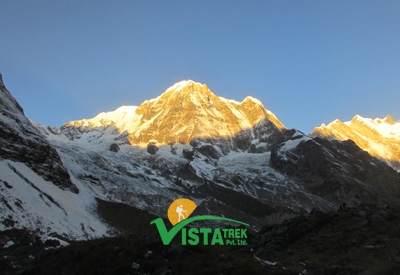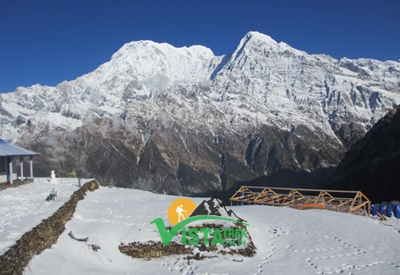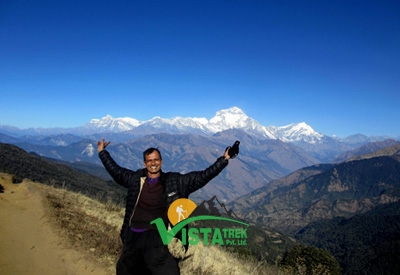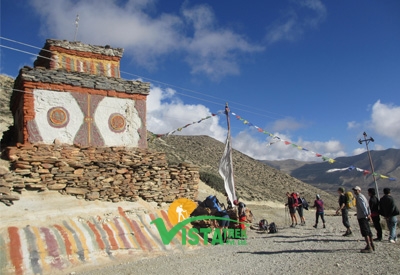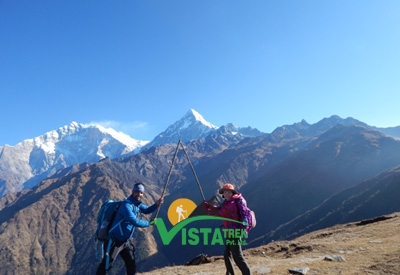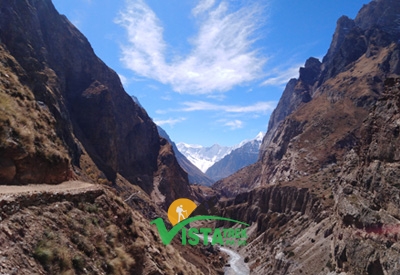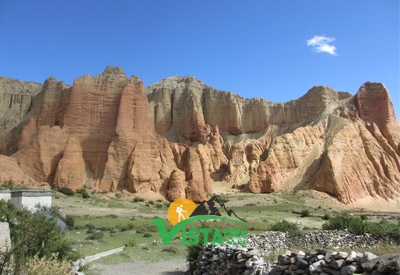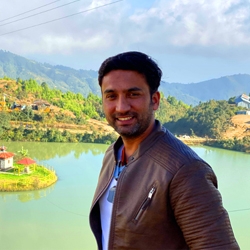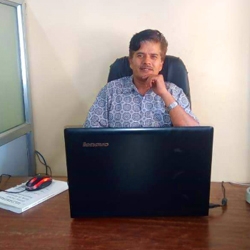Trip Facts
- Duration 10 Days
- Start FromKathmandu
- Group Size1-10 Pax
- End FromKathmandu
- Trip GradeModerate to Strenuous
- Max Height 5416 m
- AccommodationTea House
- TransportationBus/Jeep
Best Season
Sept – Nov, March – May
Trip Highlights
- Highest Trekking pass to Thorangla La Pass (5,416 metres)
- Scenic drive from Besisahar to Manang.
- Magnificent views of three different Himalayan Ranges, with each one including one Himalaya above 8000 metres: the Annapurna Range, the Manaslu Range and the Dhaulagiri Range
- Animals of interest: domesticated Yaks and a number of wild birds and animals including endangered Musk Deer, Tahr as well as several species of Eagles and Vultures
- Vegetation: from tropical to subtropical to Temperate to sub-alpine to alpine beyond the tree-line as well as apple farms in some places
- Passes through settlements that highlight the cultures of more than six different ethnic groups
Trip Overview
The Classic Annapurna Circuit Trek often required some three weeks to do the complete round. With slight changes to their itineraries, many still opt for this trek. However, now that the roads have reached higher altitudes, the options have also widened. Annapurna Circuit Short Trek (10 Days) is one such possibility.
A ride on an SUV is now possible all the way to the village of Manang. This is a trek that includes this drive to the settlement at 3,550 meters. From Kathmandu, the capital, the journey starts out on hilly highways of Nepal and goes to Besisahar and further, on a jeep, to Manang. With a day of acclimatization in the village, the walk takes to its highest elevation at Thorang-La Pass (5,416 m) and ends in Muktinath, from where it’s a drive to Jomsom and a flight to Pokhara, the lake city.
This trekking option, however, is not for the novice since the trailhead is high. Annapurna Circuit Express Trek, therefore, is ideal for those who have previous exposure to high altitude trekking and are fit.
Trip Itinerary
- Upon arrival at Tribhuwan Intl Airport in Kathmandu, a representative from Vista Trek waiting, well in time, to receive you, shall welcome you to this land of the towering Himalayas. Once reaching your hotel in a car from the airport, all you need to do is check in and enjoy the refreshment served.
- We then visit the Vista Trek office for discussion on trekking, introduction to the guide and porter and settlement of dues if any. Since you often still have some time left for a walk around Thamel, you can do so if you please.
- We head off to Beshisahar on a local bus early morning. Along the banks of the famous Trishuli and Marshyndi river, this almost six-hour journey takes all its passengers on a ride, albeit with some bumps here and there, through numerous important settlements, presenting the views of some of the Himalayas to the North. With guaranteed two stops for breakfast and lunch, the bus ride comes to its final stop in Beshisahar. Beshisahar, a small town with Gurung dominance, has grown in popularity as a trailhead for Annapurna Circuit Trek since the 1990s.
- The ride to Manang starts in the morning and passes through some famous village, ideal in their own rights. Before making that final stop in Manang, the vehicle stops at least twice, for breakfast and lunch.
- On the way, we can enjoy great view mountain, numerous waterfalls and beautiful Gurung Village.
- Overnight at guest house in Manang.
- We take a walk around after breakfast. Known as the Shangri-La, the settlement, the largest village in Manang District, radiates a distinct Buddhist aura –prayer wheels, prayer flags, prayer stones and mani walls.
- We hike to Gangapurna Lake before lunch. The blue-green lake, fed directly by the Gangapurna glaciers, appears like a large body of still water in the crater of a volcano. A gentle walk of around 300 metres up the hill to the left of the lake serves as a vantage point, welcoming its visitors, standing at an altitude of 3,800 metres to experience a wide view of the notable peaks of the Annapurna Region from just above the magnificent Lake – Mt Annapurna II and III, Mt Gangapurna, Mt Tilicho, Mt Chulu as well as a large portion of the Marshyangdi River Valley including the settlement of Manang.
- Walk back to Manang Village and spend the night in a hotel.
- After breakfast, we walk for about 2 hours to Gunsang. Although the path is a gradual uphill throughout, the altitude makes up for its earthen mate, making it arduous in a moreexhausting sense than painful, owing much to the thinning of the air in higher altitudes. The gradual decline in vegetation, which finally gives in to the nature leaving the landscape almost barren by the next two hours’ walk, also cautions everyone traversing of the harshness of the terrain. The tea break at Gunsang comes as a welcome retreat after an hour and a half’s walk. Blown away by the view from this point, many are, in fact, forced to stop for around half an hour in appreciation; along with the Annapurna Range and Marshyandi River Valley with Manang Village still visible but distancing away, the panorama now also includes the Manaslu Range beyond the end of the valley.
- We start walking again after this break to Yak Kharka. Developed solely to facilitate trekkers, the small settlement in Yak Kharka is ideally located for a much better view of Mt Chulu than from most other places in the region.
- Spend the night in a teahouse in this settlement.
- We start trek after breakfast and stop at a small tea hut after around 2 ½ hours’ walk. Bringing the Thorang Peak closer and closer, bringing inthe West of Mt Chuluin view round a hill in about half an hour, presentinga small streamto cross after the next hour, the route turns uphill from here on.Along the way, the relative discomfort of the trail is well compensated by the sight of a herd of Tahrjumping on rocky slopes most would not dare to.The first of the only two huts in this part of the trail approaches, encouraging a short break. Providing tea and coffee and selling only a few items such as chips, cookies and chocolates, the service, run by a couple in their thirties, comes without any proper sitting arrangement; the best anyone is likely to get is a roughly nailed plank on two single bamboo pillars on each side.
- After this break, we walk again for an hour and a half to ThorangPhedi. A gradual uphill along a stream all the way, the trail calls for exercising extra caution against falling stones at some of its reconstructed parts that get in the way of the landslides each year. In about an hour and a half, the trail brings its travelers to ThorangPhedi for lunch. The only twoconstructions in the area are able to render their services to around 200 people at a go, enough even for the crowd in the peak season.
- After lunch, we startwalking once more for nearly an hour to Thorang High Camp. Testing times. This hour long steep uphill into higher lands after almost four hours of lumbering on this tenth dayappears never ending, lending strength to the concept of relativity with regard to distance, time and difficulty. The sight of two buildings closing in, towards the final stages of this stretched hour would perhaps never look so rewarding except in times like these. To everyone’s relief, of the two, the bigger remains open throughout.
- We start trek early morning (at around 5 am) and stop at Thorangla Pass after approximately three and a half hours. After a very early tea, we pack our lunch and start the walk up a meandering incline. Known for its indiscriminating character, this gruesome steep climb is the most challenging of all days claim many. The only relief on this part for any trekker is, perhaps, the thought that one would soon have a first-hand experience of stopping by in Thorangla Pass, the one at the highest altitude of 5,416 metres.With Thorang Peak right above the head, the Pass today also houses prayer flags along with the regular ice and boulders. For us, it’s breakfast time on this border that separates Manang and Mustang Districts.
- After taking our packed food at the top of Thorang top, we walk again for two and a half hours to Thorang Phedi, leaving Manang and officially entering Mustang. A gradual downhill, unlike a waterfall but more like a steady river, brings Mt.Dhaulagiri in sight after around ten minutes.The surrounding, barren desert-like landscape, presents harsh conditions challenged only bya few species of adamant shrubs and grasses. The arrival of Thorang Phedi, a temporary settlement with only a few huts that serve tea, coffee and the like, allows the legs to rest with that much needed break.
- After the break, we start walking again for around an hour and a half to Muktinath. With the Muktinath temple on the way and a lot of similarity to the one just travelled, the route, eventually, lands everyone in Ranipauwa.
- Its final day in the mountain. We take breakfast with magnifiscient view of Dhalaguri and Nilgiri from Muktinath and start out scenig drive to Pokhara.
- It's pleasant ride passing through ancient Buddhist village such as Kagbeni, Jomsom and Marpha. As the drive goest through deep valley made by kaligandaki river, the apple farms, Waterfalls and mountain views continuiusly pleased our eyes throught out the day.
- Upon Arrival in Pokhara, A stroll around Phewa Lake is worth and so is a drink by the lake. We stay the night here.
- We head off to Kathmandu on a tourist bus early morning. This almost six-hour journey passes through numerous important settlements with guaranteed two stops for breakfast and lunch. The bus ride finally comes to its stop in Kathmandu.
- Back in Kathmandu, and only your WILL shall dictate your involvement or indulgence as you may please since our arrival is in the afternoon. In the evening, however, please allow us the pleasure of your company during the fare-well dinner organized by Vista Trek.
- Spend the night in a hotel.
- If you have a morning flight, we leave for Tribhuwan Intl Airport early morning in a car arranged by the office.
- If your flight is in the late afternoon or evening, only your WILL shall dictate your involvement or indulgence as you may please before leaving for Tribhuwan Intl Airport in the vehicle.
Cost Includes
- Pick up and transfer by car from Airport-Hotel-Airport.
- 2 nights Deluxe hotel accommodation in Kathmandu and one night in Pokhara as per the itinerary.
- Breakfast, lunch and dinner with tea/coffee during the trek.
- Local lodges accommodation during the trek.
- Government licensed guide,plus experience porters ( including his food, salary, accommodation, equipment, medicine & insurance).
- All local transportation by bus as per the itinerary.(Jeep driving from Besisahar-Chame and tourist bus to Pokhara -kathmandu)
- Jomsom to Pokhara one way flight ticket with airport tax.
- All necessary permits and entry fees.
- Medical kit box.
- Rescue assistance.
- All government taxes.
- Necessary equipment (sleeping bags, down jackets etc. if needed).
- Trekking Map
- Vista Trek’s T-shirt as a souvenir.
- Our service charge.
Cost Excludes
- Meals in Kathmandu & Pokhara.
- International airfare.
- Nepal entry visa fee ($40).
- Your travel insurance (should include your medical and rescue).
- Any personal expenses.
- Bar bills.
- Staff & driver tipping.
Trip Map
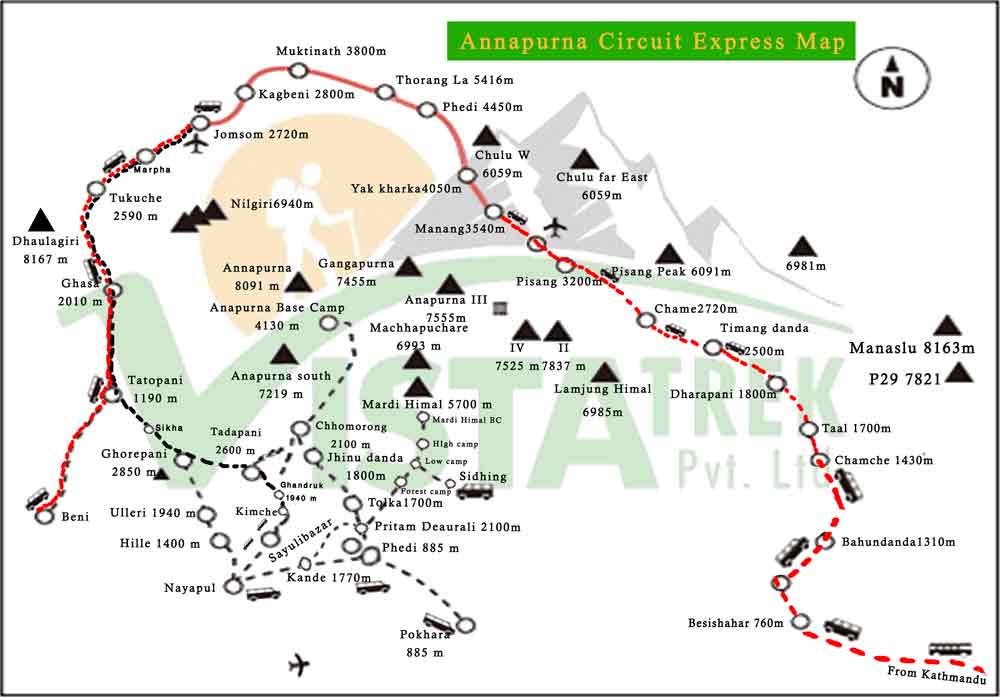
Useful Info
About Accommodation.
In Kathmandu, we will accommodate you at Hotel Sapana Garden. Local lodges accommodation provided during the trek on twin sharing basis. Hotel in Kathmandu comes with private bathroom , however in mountain, toilet and shower will be on sharing basis. In the busy months, (October/November & April/ May) you may have to share the room with other traveler as some villages have limited number of local lodges .
About Meal
You can enjoy typical Nepali food as well as continental , Italian, Indian and Tibetan. Dinner and breakfast serve at the teahouse where we stay and lunch will be served on the way to next destination. In Kathmandu, only breakfast is provided. If you are a vegetarian or vegan, no worries, Nepal is such a easy place to get several vegetarian options.
About Staff:
A Guide and a porter assist you from Kathmandu to Kathmandu. In a group with more than 8 guests, 2 guide will be provided. A porter provided for 2 trekkers, and carries between 15 to 20 K.G.
About Equipments
Following Equipment list is recommended to bring for the trek.
Down Sleeping Bag, Down Jacket, Long sleeved shirt, Jumper or fleecy jacket, T – shirts, Trekking shoes or boots, Comfy shoes for around the camp, thick and warm woolen socks, Light cotton socks , A day bag to carry your valuable, Sun hat, Woolen hat, Gloves, rain coat, Sun block, lip balm , Goggles or sunglasses, Long underwear, Thermal wear, Nylon windbreaker, Nylon wind pants, Water bottle, Sewing kit, Medical & first aid kit, Flash light, Batteries and bulbs, Swiss army knife, Towel and toiletries etc. Please kindly check our Equipment list for complete details.
About Temperature.
Temperatures vary as per the elevation and season in Annapurna. Spring (March to May) and Autumn (September to December) is quite warm below 3000m that you can walk with t-shirts and shorts during day. Above Manang, day time temperature is around 5-10 °C and night time temperature is below 0 °C. Above Manang is generally cold through out a year and night time temperature can reach up to–20 °C in winter. There are no heating system inside the room in guest houses, therefore it is important to prepare warm clothes and sleeping bag for the trek.
Physical Fitness and experience
Annapurna Circuit Short Trek is a challenging trek which is fit for those who has the ability to walk 5-6 hours ups and downs in a day carrying own day bag. Some days are even longer with 7- 8 hours of walking, therefore this is not suitable for the beginner. This is high altitude trek which demands more physical fitness, However if you are strongly determined and have excellent health and average physical fitness can complete this trek. Few weeks prior to the trip, doing some physical exercise is better . No technical skill is needed however past experience also helps . If you are taking medicine for heart, lung or for blood diseases, please kindly consult your doctor and inform to Vista Trek P. Ltd.
About Insurance,
You have to obtain the travel insurance which should cover emergency evacuation and medical expenses. Some Insurance policy’s cover only up to 4000 meter, so please kindly confirm with the insurance company before you purchase it.
About Seasons
Spring and autumn seasons are the ideal seasons for Annapurna Circuit Short Trek. This is also known as rain shadow area, which is located right behind of Annapurna Mastiffs having least amount of rain compare to other area of Nepal. Therefore Raining season (June/July/August) is also good time for Annapurna Circuit Trek. Winter (December to February ) is generally not suitable for this Trek as the temperature is extremly cold and Thorang la Pass is also cover by heavy snow. But people with an experience of snow walking and used to in extream cold can complete this trek in winter too.
About Bus Drive
Highway in Nepal are safe, however sometime transport can be halted due to landslide , strike or by political issues. In such case trip itinerary will be affected. Thus, we would like to request you to add few days extra in Kathmandu. If you complete your trip smoothly, then you can enjoy your time with other activities like sightseeing, White water rafting. Jungle activities or more.
Please cheque our FAQs for various issues of the trek.
Trip Review

Great time in Annapurna
Originally we planned to do the Gokyo Trek but due to weather problems in Lukla the flights were cancelled for several day and we needed to reschedule to meet our given and limited time frame. Vista Trek was very very helpful and flexible and it was no problem to change the trek and organize everything in a short period of time. We experience a perfect Annapurna Circuit Trek with a super guide and grate porter that were always friendly and that we had a lot of fun with. They were both well equipped. As we found out that is not always the case with other agencies. The rooms in the lodge were nice although it was pick season and it was a big effort to organize those for which we thank our Guide and Porter. We thank Vista Trek, Gyane and Prem for this wonderful experience and we highly appreciate their effort and professional organization that we can really recommend.




